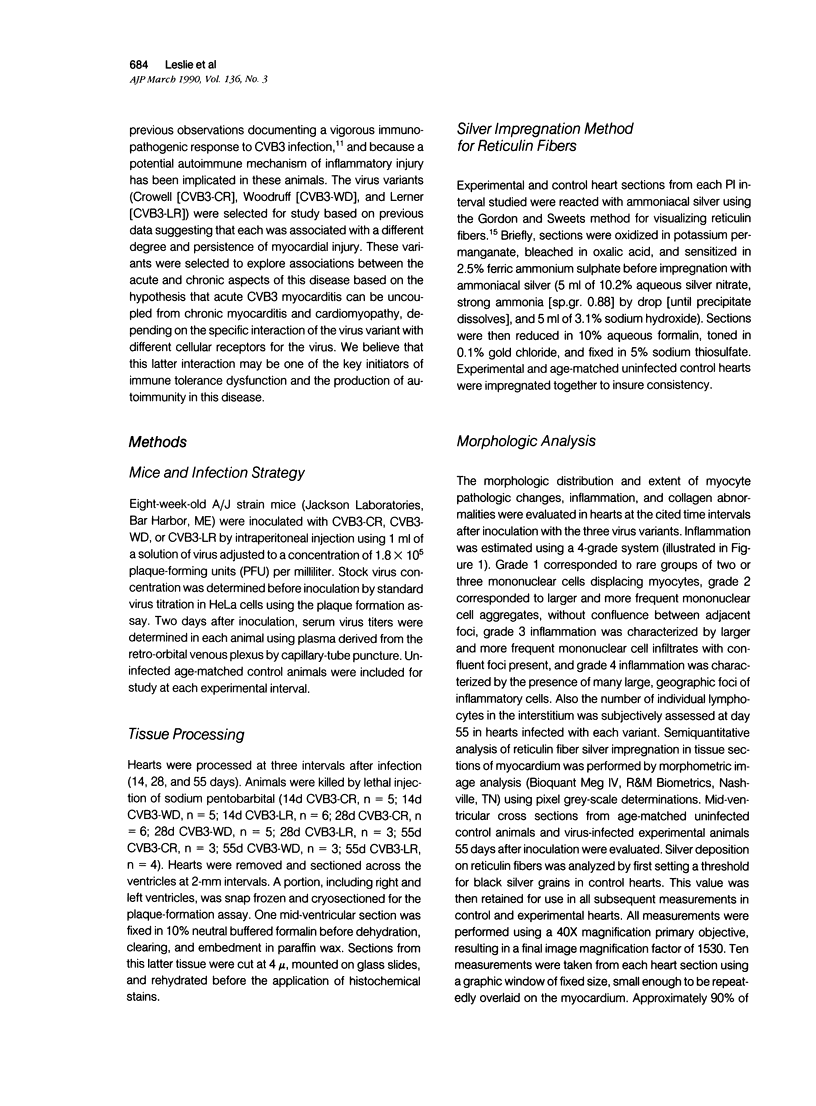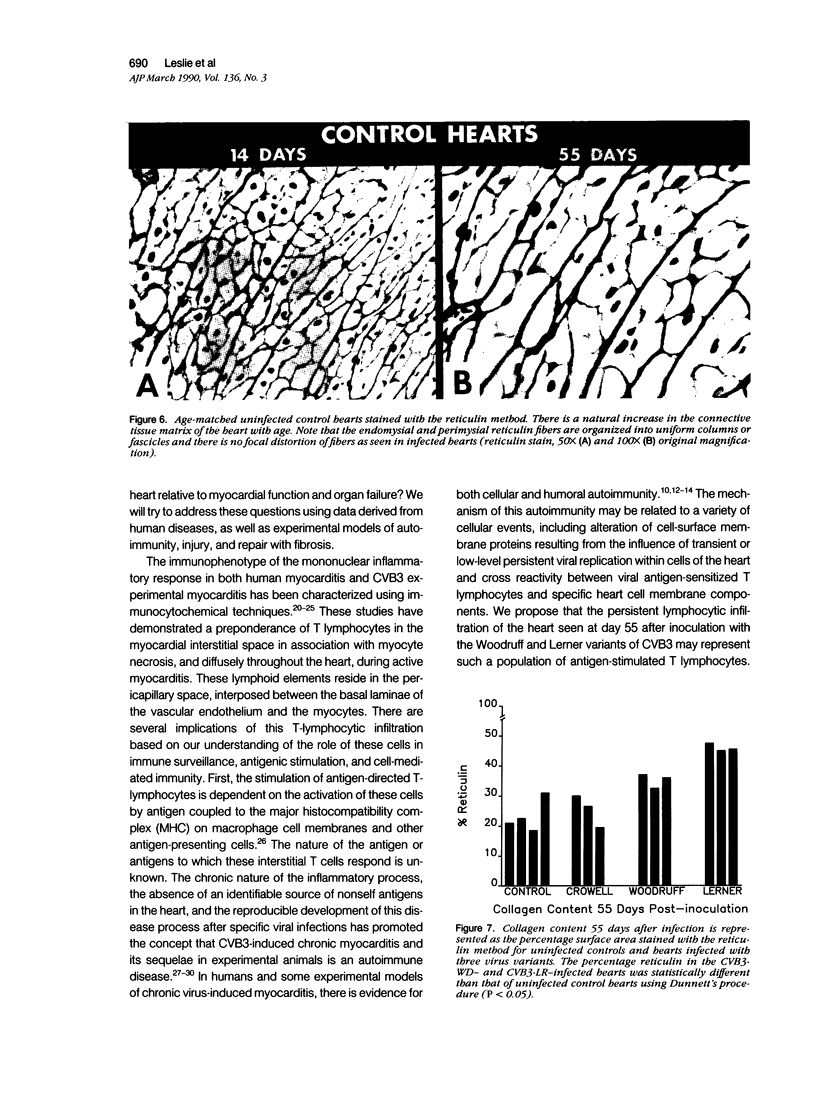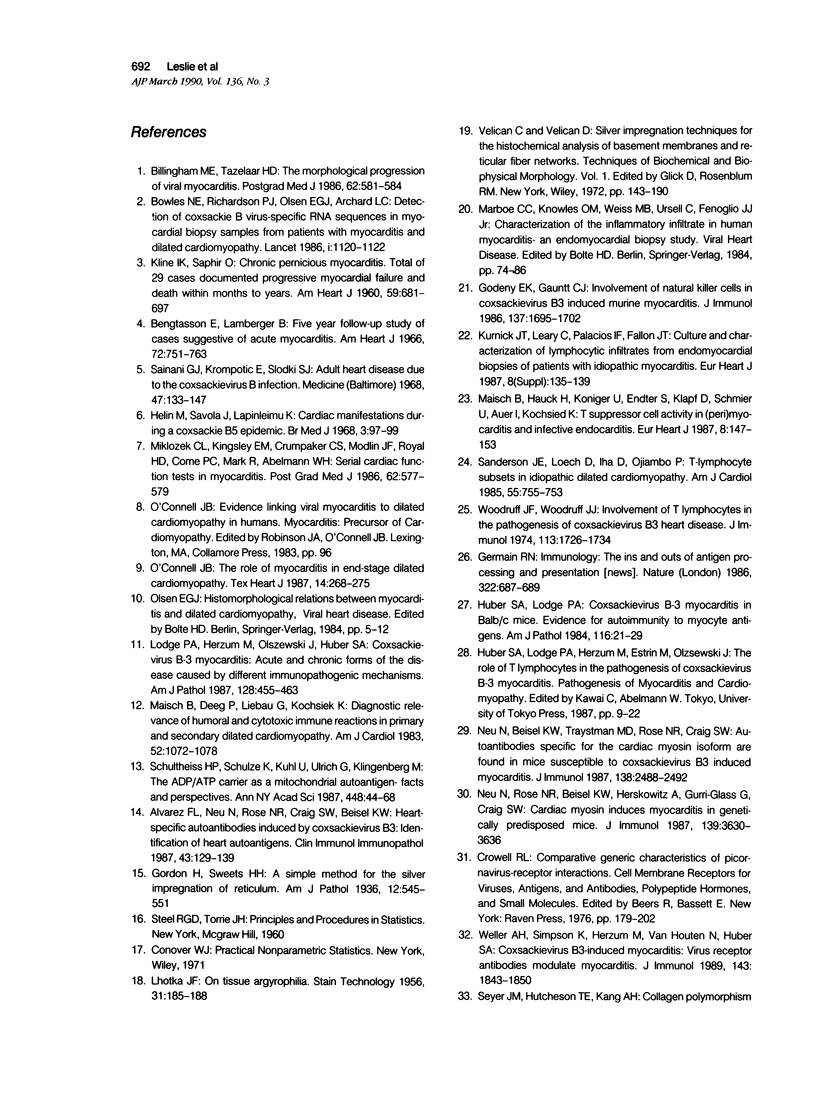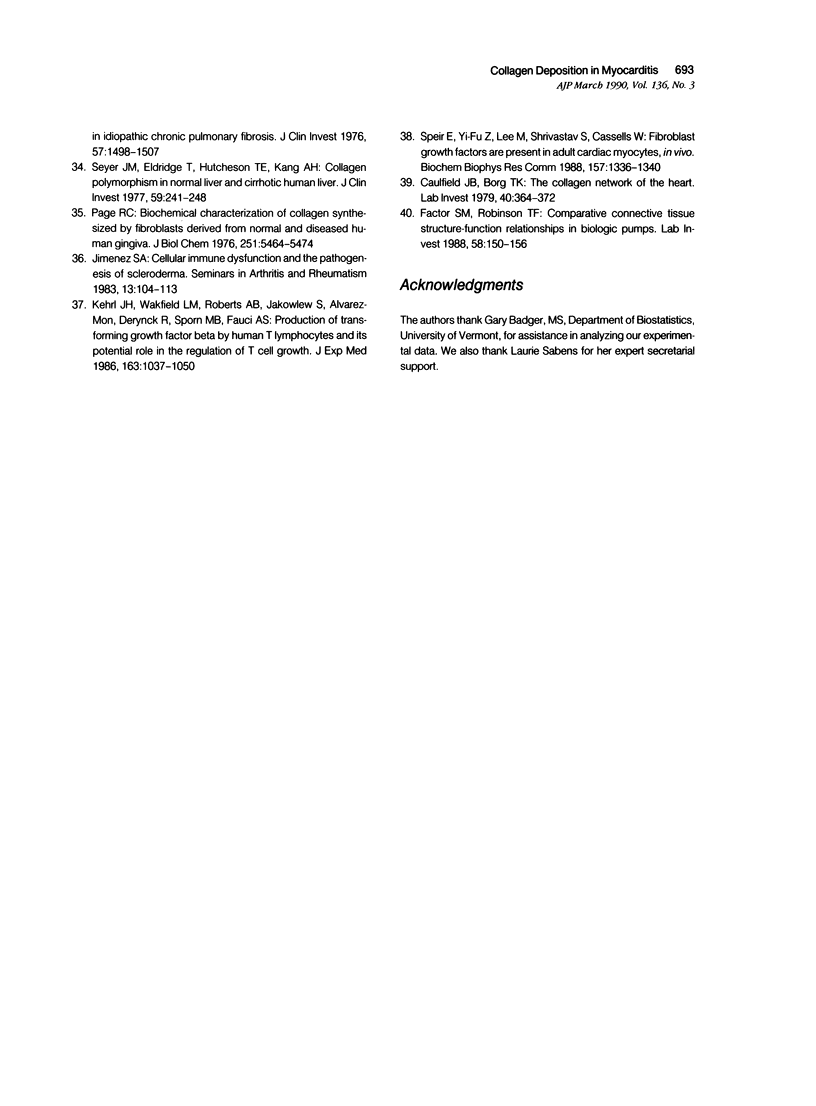Abstract
Myocardial fibrosis can be produced in certain inbred strains of mice after coxsackievirus B subtype 3 (CVB3) infection. The mechanism responsible for this interstitial matrix alteration is unknown. The presumption is that fibrosis occurs in areas of myocyte damage and inflammation associated with viral infection, analogous to scar formation after cell injury in other organ systems. To test this hypothesis, we examined the hearts of A/J strain mice infected with three CVB3 variants (Crowell [CVB3-CR], Woodruff [CVB3-WD], and Lerner [CVB3-LR]), each known to cause different degrees of acute myocardial injury. With these three variants, virus was present in the heart until day 28 after inoculation but was absent thereafter. Fourteen days after inoculation, inflammation with myocyte necrosis was seen in discrete foci throughout the myocardium with all three variants. Collapse and disorganization of the usually delicate connective tissue matrix identifiable by silver impregnation was seen in these areas of myocyte injury. Persistent, diffuse lymphocytic infiltration of the myocardium was seen 55 days after inoculation with CVB3-WD and CVB3-LR, but hearts initially infected with CVB3-CR showed only rare interstitial lymphocytes comparable to uninfected control hearts. The focal scars produced by myocyte necrosis 14 days after inoculation were accentuated and heavily collagenized 55 days after inoculation with CVB3-WD and CVB3-LR; however, these foci were indistinct 55 days after inoculation with CVB3-CR. Furthermore, the usually delicate network of interstitial collagen fibers surrounding individual myocytes became thickened throughout the heart 55 days after inoculation with CVB3-WD and CVB3-LR, away from visibly scarred areas produced early after infection with these variants. This diffuse reticulin thickening was not seen after infection with the Crowell variant. Only the virus variants associated with persistent interstitial inflammation at day 55 developed major collagen matrix alterations and interstitial fibrosis. We conclude that this persistent interstitial lymphocytic infiltration reflects altered immune function related to specific virus variants in this animal strain. We postulate that these lymphocytes are part of a delayed immunopathogenic response uncoupled from the original viral injury and inflammatory damage. Potential mechanisms by which this interstitial lymphocytic infiltration results in fibrosis are discussed.
Full text
PDF










Images in this article
Selected References
These references are in PubMed. This may not be the complete list of references from this article.
- Alvarez F. L., Neu N., Rose N. R., Craig S. W., Beisel K. W. Heart-specific autoantibodies induced by Coxsackievirus B3: identification of heart autoantigens. Clin Immunol Immunopathol. 1987 Apr;43(1):129–139. doi: 10.1016/0090-1229(87)90164-4. [DOI] [PubMed] [Google Scholar]
- Bengtsson E., Lamberger B. Five-year follow-up study of cases suggestive of acute myocarditis. Am Heart J. 1966 Dec;72(6):751–763. doi: 10.1016/0002-8703(66)90158-x. [DOI] [PubMed] [Google Scholar]
- Billingham M. E., Tazelaar H. D. The morphological progression of viral myocarditis. Postgrad Med J. 1986 Jun;62(728):581–584. doi: 10.1136/pgmj.62.728.581. [DOI] [PMC free article] [PubMed] [Google Scholar]
- Caulfield J. B., Borg T. K. The collagen network of the heart. Lab Invest. 1979 Mar;40(3):364–372. [PubMed] [Google Scholar]
- Factor S. M., Robinson T. F. Comparative connective tissue structure-function relationships in biologic pumps. Lab Invest. 1988 Feb;58(2):150–156. [PubMed] [Google Scholar]
- Germain R. N. Immunology. The ins and outs of antigen processing and presentation. Nature. 1986 Aug 21;322(6081):687–689. doi: 10.1038/322687a0. [DOI] [PubMed] [Google Scholar]
- Godeny E. K., Gauntt C. J. Involvement of natural killer cells in coxsackievirus B3-induced murine myocarditis. J Immunol. 1986 Sep 1;137(5):1695–1702. [PubMed] [Google Scholar]
- Gordon H., Sweets H. H. A Simple Method for the Silver Impregnation of Reticulum. Am J Pathol. 1936 Jul;12(4):545–552.1. [PMC free article] [PubMed] [Google Scholar]
- Haeusler G. Potential future developments in the field of antihypertensive drugs. Eur Heart J. 1987 Dec;8 (Suppl 1000):135–142. doi: 10.1093/eurheartj/8.suppl_m.135. [DOI] [PubMed] [Google Scholar]
- Helin M., Savola J., Lapinleimu K. Cardiac manifestations during a Coxsackie B5 epidemic. Br Med J. 1968 Jul 13;3(5610):97–99. doi: 10.1136/bmj.3.5610.97. [DOI] [PMC free article] [PubMed] [Google Scholar]
- Huber S. A., Lodge P. A. Coxsackievirus B-3 myocarditis in Balb/c mice. Evidence for autoimmunity to myocyte antigens. Am J Pathol. 1984 Jul;116(1):21–29. [PMC free article] [PubMed] [Google Scholar]
- Jiménez S. A. Cellular immune dysfunction and the pathogenesis of scleroderma. Semin Arthritis Rheum. 1983 Aug;13(1 Suppl 1):104–113. doi: 10.1016/0049-0172(83)90029-x. [DOI] [PubMed] [Google Scholar]
- KLINE I. K., SAPHIR O. Chronic pernicious myocarditis. Am Heart J. 1960 May;59:681–697. doi: 10.1016/0002-8703(60)90510-x. [DOI] [PubMed] [Google Scholar]
- Kehrl J. H., Wakefield L. M., Roberts A. B., Jakowlew S., Alvarez-Mon M., Derynck R., Sporn M. B., Fauci A. S. Production of transforming growth factor beta by human T lymphocytes and its potential role in the regulation of T cell growth. J Exp Med. 1986 May 1;163(5):1037–1050. doi: 10.1084/jem.163.5.1037. [DOI] [PMC free article] [PubMed] [Google Scholar]
- LHOTKA J. F. On tissue argyrophilia. Stain Technol. 1956 Sep;31(5):185–188. doi: 10.3109/10520295609113801. [DOI] [PubMed] [Google Scholar]
- Lodge P. A., Herzum M., Olszewski J., Huber S. A. Coxsackievirus B-3 myocarditis. Acute and chronic forms of the disease caused by different immunopathogenic mechanisms. Am J Pathol. 1987 Sep;128(3):455–463. [PMC free article] [PubMed] [Google Scholar]
- Maisch B., Deeg P., Liebau G., Kochsiek K. Diagnostic relevance of humoral and cytotoxic immune reactions in primary and secondary dilated cardiomyopathy. Am J Cardiol. 1983 Nov 1;52(8):1072–1078. doi: 10.1016/0002-9149(83)90535-0. [DOI] [PubMed] [Google Scholar]
- Miklozek C. L., Kingsley E. M., Crumpaker C. S., Modlin J. F., Royal H. D., Come P. C., Mark R., Abelmann W. H. Serial cardiac function tests in myocarditis. Postgrad Med J. 1986 Jun;62(728):577–579. doi: 10.1136/pgmj.62.728.577. [DOI] [PMC free article] [PubMed] [Google Scholar]
- Narayanan A. S., Page R. C. Biochemical characterization of collagens synthesized by fibroblasts derived from normal and diseased human gingiva. J Biol Chem. 1976 Sep 25;251(18):5464–5471. [PubMed] [Google Scholar]
- Neu N., Beisel K. W., Traystman M. D., Rose N. R., Craig S. W. Autoantibodies specific for the cardiac myosin isoform are found in mice susceptible to Coxsackievirus B3-induced myocarditis. J Immunol. 1987 Apr 15;138(8):2488–2492. [PubMed] [Google Scholar]
- Neu N., Rose N. R., Beisel K. W., Herskowitz A., Gurri-Glass G., Craig S. W. Cardiac myosin induces myocarditis in genetically predisposed mice. J Immunol. 1987 Dec 1;139(11):3630–3636. [PubMed] [Google Scholar]
- O'Connell J. B. The role of myocarditis in end-stage dilated cardiomyopathy. Tex Heart Inst J. 1987 Sep;14(3):268–275. [PMC free article] [PubMed] [Google Scholar]
- Sainani G. S., Krompotic E., Slodki S. J. Adult heart disease due to the Coxsackie virus B infection. Medicine (Baltimore) 1968 Mar;47(2):133–147. doi: 10.1097/00005792-196803000-00003. [DOI] [PubMed] [Google Scholar]
- Sanderson J. E., Koech D., Iha D., Ojiambo H. P. T-lymphocyte subsets in idiopathic dilated cardiomyopathy. Am J Cardiol. 1985 Mar 1;55(6):755–758. doi: 10.1016/0002-9149(85)90151-1. [DOI] [PubMed] [Google Scholar]
- Seyer J. M., Hutcheson E. T., Kang A. H. Collagen polymorphism in normal and cirrhotic human liver. J Clin Invest. 1977 Feb;59(2):241–248. doi: 10.1172/JCI108634. [DOI] [PMC free article] [PubMed] [Google Scholar]
- Weller A. H., Simpson K., Herzum M., Van Houten N., Huber S. A. Coxsackievirus-B3-induced myocarditis: virus receptor antibodies modulate myocarditis. J Immunol. 1989 Sep 15;143(6):1843–1850. [PubMed] [Google Scholar]
- Woodruff J. F., Woodruff J. J. Involvement of T lymphocytes in the pathogenesis of coxsackie virus B3 heart disease. J Immunol. 1974 Dec;113(6):1726–1734. [PubMed] [Google Scholar]







